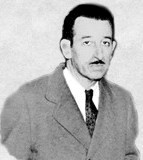On the morning of April 23, 1955, John J. Cowles Jr., scion of the Cowles publishing empire, was backing his Pontiac out of his Lake of the Isles garage, in Minneapolis, when he noticed what appeared to be a bundle of clothes in the alley. When he got out of his car to inspect, Cowles discovered the lifeless body of a young woman.
When the police arrived, they turned the body over and discovered that the woman's face had been scratched and bruised, and that her throat bore a bluish mark. They dug through her coat pockets and found a wallet. Inside was a five-dollar bill, a doctor's prescription slip, and a driver's license identifying her as Elizabeth Mary Moonen, age 21, of 9 East 17th St. in Minneapolis. After securing the crime scene, the body was transported to Minneapolis General.
Coe chose a young intern, Dr. Fred Brauti, as his assistant for the Moonen autopsy. That afternoon Brauti began the procedure by making a Y-shaped incision in Moonen's chest, opened the rib cage, and removed organs for Coe to examine. The heart looked normal, but the lungs were congested--a possible indicator of suffocation. There was injury to the brain, too, caused, it seemed, by a lack of oxygen rather than a blow. Her facial injuries were consistent with a struggle.
Then Coe examined her throat. "Very commonly in manual strangulation, the small bone in the larynx is crushed or fractured," he explains. "On the outside, you look for bruises. On the inside, you'll find bleeding at the site." Coe found both, and declared Moonen's death a homicide.
During the course of the autopsy, Coe also discovered that Moonen was three months pregnant. Traces of semen in her vagina led him to conclude that she'd had intercourse just prior to her death. Since her husband had been stationed in Korea for the past year, Coe's findings were critical in drawing up a list of suspects. Police investigators first turned to the physician who'd signed the prescription, Dr. Glen Peterson.
Peterson confirmed that Moonen was indeed his patient, and told investigators that Moonen identified the baby's father as a local dentist by the name of Arnold Axilrod. Axilrod was 49 years old and had a reputation as a ladies' man.
His office was above the Hoop De Do nightclub at 16th Street and Nicollet Avenue, and his patients were mainly nightclub performers and hat check girls. Since he began practicing in 1928, the only blemish to his reputation appeared to be an anonymous phone call made to the police six months before Moonen was killed.
The caller told police that Axilrod had sedated her during an office visit and raped her while she was unconscious. Since Axilrod's accuser refused to reveal her name or to file a complaint, her allegations were never investigated.
When the police questioned Axilrod, he admitted that he'd given Moonen a ride on the evening of her death, and the two had quarreled. According to police records, Axilrod told the investigators that "[Moonen] accused me of being the father, and said she'd expose me to the world."
The next thing he knew, Axilrod continued, he'd blacked out; when he came to, Moonen was no longer in the car. When the police told him that Moonen had been choked to death, Axilrod replied, "If she was strangled, I must have done it. I was the only one there." He would later recant that statement.
In the fall of 1955, Axilrod went on trial for murder in Hennepin County District Court. By then the case had garnered national attention, and a seat in the courtroom was one of the hottest tickets going.
Defending Axilrod was local criminal defense attorney Sydney Goff, whom local newspapers took to calling "The new Clarence Darrow of the Midwest." Before the trial began, however, Coe contracted hepatitis, and his doctor refused to allow him to testify. The strongest piece of evidence, the autopsy report, would be delivered by Dr. Brauti.
"I felt so bad for him," Coe recalls. "I considered myself to be inexperienced, and he had even less training and had to go up against Syd Goff in open court." As Brauti struggled through his testimony, Coe worked on convincing his internist to allow him into the courtroom. "At first he said I could go to court in my hospital bed, but there was no way I was going to do that. I was finally able to convince him to let me testify in a wheelchair."
Ultimately, Coe's command of forensic pathology established his reputation as an astute expert witness, and sealed Axilrod's fate. "I explained to the jury how the bruises on her neck were consistent with strangulation, and that my internal examination confirmed that conclusion, given that this is the only way to break or fracture the hyoid bone. I'd conducted a very thorough autopsy and was confident of my findings," Coe says.
At the end of the weeks-long trial, the jury found Axilrod guilty of manslaughter--a verdict, accompanied by a five- to twenty-year sentence, based on police work and on Coe's irrefutable testimony.
"The Axilrod case made me realize how little I knew about forensic medicine," Coe says. "I realized that if I was going to be called on in the future to testify in court, I was going to have to be better educated."
At the time, however, the only formal training available was an eight-week course administered by the Armed Forces Institute of Pathology (AFIP). His coursework there was helpful, but fell far short of supplying him with the knowledge needed to conduct the kinds of investigations a rising violent-crime rate in the county called for.

